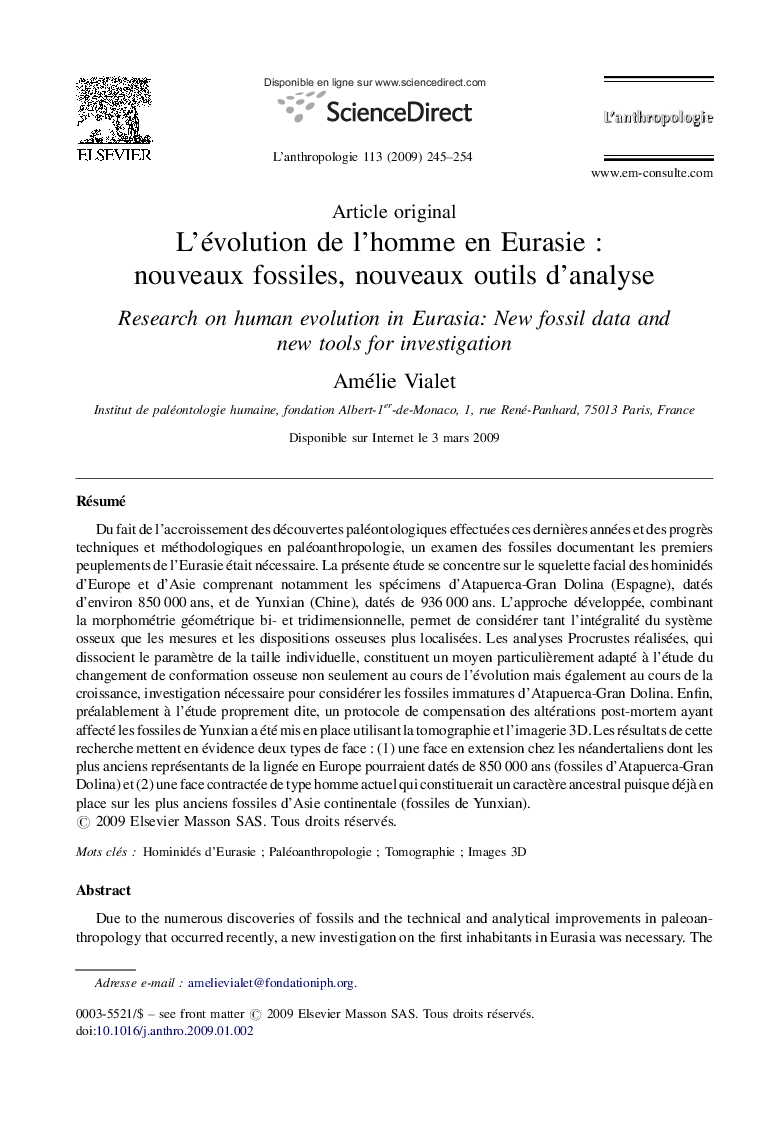| Article ID | Journal | Published Year | Pages | File Type |
|---|---|---|---|---|
| 1033923 | L'Anthropologie | 2009 | 10 Pages |
RésuméDu fait de l’accroissement des découvertes paléontologiques effectuées ces dernières années et des progrès techniques et méthodologiques en paléoanthropologie, un examen des fossiles documentant les premiers peuplements de l’Eurasie était nécessaire. La présente étude se concentre sur le squelette facial des hominidés d’Europe et d’Asie comprenant notamment les spécimens d’Atapuerca-Gran Dolina (Espagne), datés d’environ 850 000 ans, et de Yunxian (Chine), datés de 936 000 ans. L’approche développée, combinant la morphométrie géométrique bi- et tridimensionnelle, permet de considérer tant l’intégralité du système osseux que les mesures et les dispositions osseuses plus localisées. Les analyses Procrustes réalisées, qui dissocient le paramètre de la taille individuelle, constituent un moyen particulièrement adapté à l’étude du changement de conformation osseuse non seulement au cours de l’évolution mais également au cours de la croissance, investigation nécessaire pour considérer les fossiles immatures d’Atapuerca-Gran Dolina. Enfin, préalablement à l’étude proprement dite, un protocole de compensation des altérations post-mortem ayant affecté les fossiles de Yunxian a été mis en place utilisant la tomographie et l’imagerie 3D. Les résultats de cette recherche mettent en évidence deux types de face : (1) une face en extension chez les néandertaliens dont les plus anciens représentants de la lignée en Europe pourraient datés de 850 000 ans (fossiles d’Atapuerca-Gran Dolina) et (2) une face contractée de type homme actuel qui constituerait un caractère ancestral puisque déjà en place sur les plus anciens fossiles d’Asie continentale (fossiles de Yunxian).
Due to the numerous discoveries of fossils and the technical and analytical improvements in paleoanthropology that occurred recently, a new investigation on the first inhabitants in Eurasia was necessary. The research deals with the facial pattern of the fossil hominids from Europe and Asia and focussed on the ones discovered in the Atapuerca-Gran Dolina site in Spain, which are oldest than 850,000 years and in the Yunxian site in China, which are dated by 936,000 years. Methods used combined 2D and 3D morphometrics providing with the possibility to consider not only the overall conformation but also the more localized measurements. The Procrustes analysis, which put apart the individual size parameter, were used to investigate the morphological alteration of the face during growth in order to interpret the facial conformation juvenile fossils such as those from Atapuerca-Gran Dolina. Moreover, a specific protocol using tomography and 3D imaging techniques was carried out to reconstruct the Yunxian specimens which have been badly crushed during fossilization process. The results of this research put in light two facial patterns: (1) a facial pattern in extension expressed in Neandertals which european lineage could have been older than previously thought including the Atapuerca-Gran Dolina specimens and (2) a facial pattern in contraction shared between modern humans and the oldest fossil hominids from continental Asia (i.e. Yunxian specimens) which suggests that this conformation corresponds to a primitive condition.
